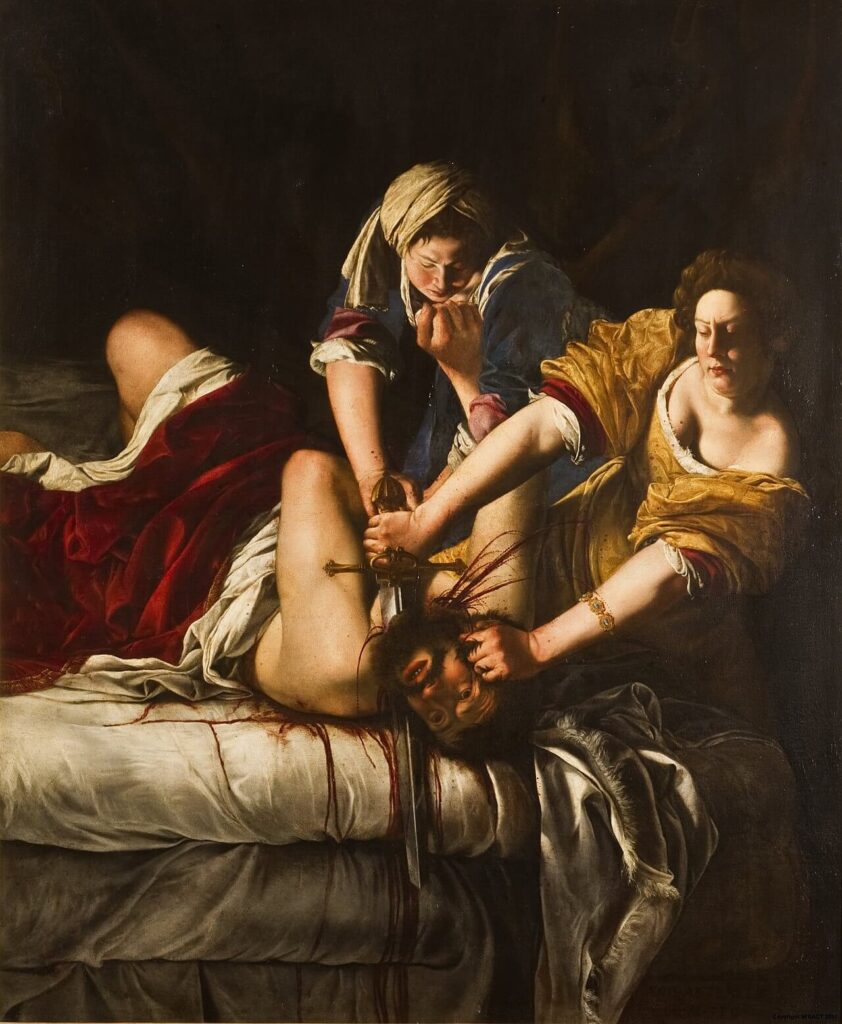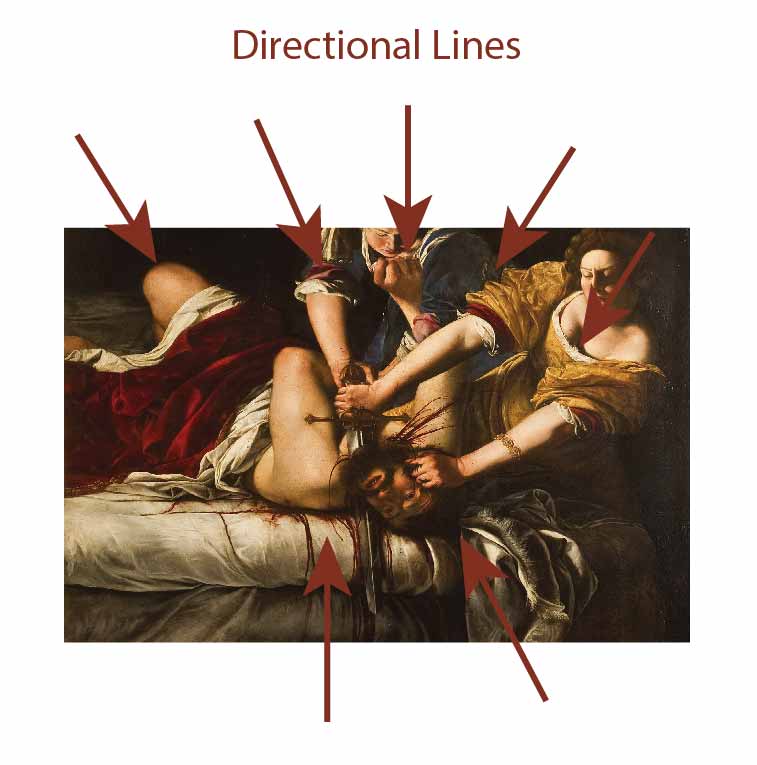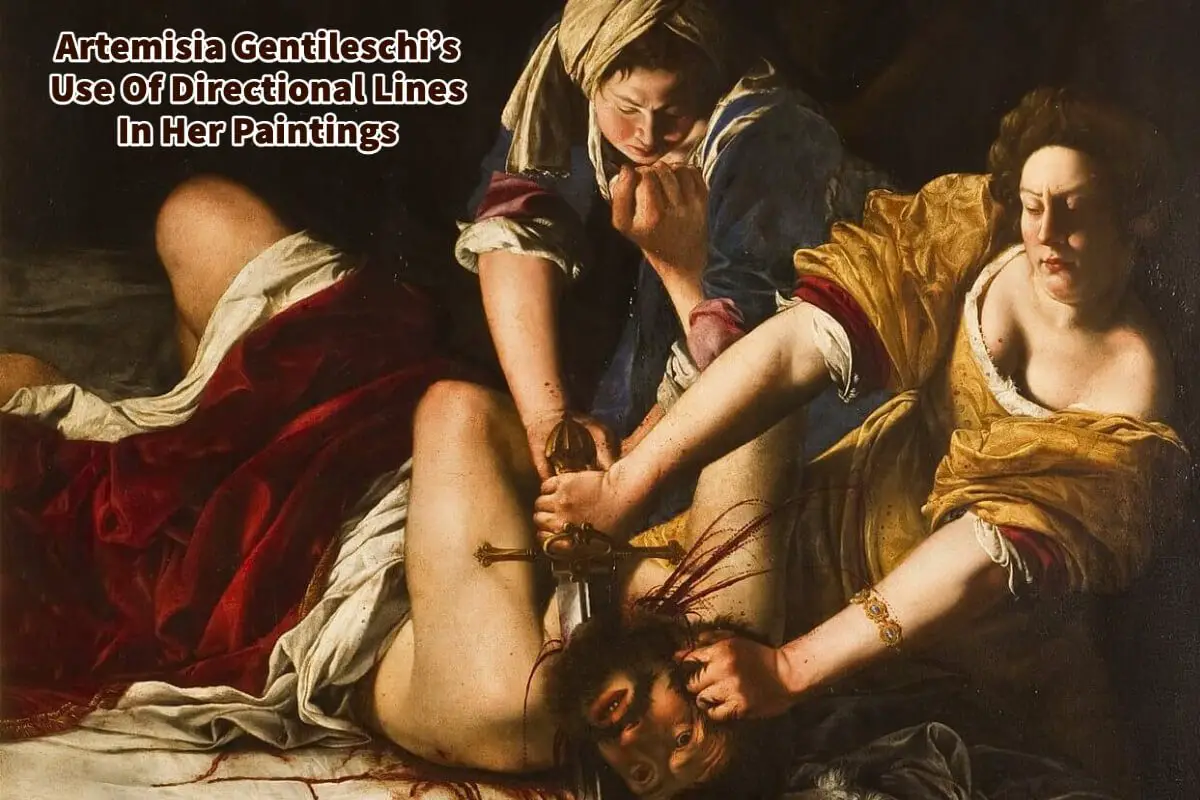Artemisia Gentileschi understood the power of what directional lines could do to create a focal point for her paintings. She knew that our eyes would focus at the pivotal point by using the principles of directional lines and contrasting colors.
Artemisia Gentileschi’s painting Judith Decapitates Holofernes is a masterwork of art about using directional lines properly. In this painting, she used directional lines, including horizontal lines, to draw our attention to the focal point of Judith beheading Holofernes.
Table of Contents
- Artemisia Gentileschi – A Master Of Directional Lines
- Judith Decapitating Holofernes
- Artemisia Gentileschi’s Use Of Dramatic Contrasts
- Frequently Asked Questions
- Related Questions
Artemisia Gentileschi – A Master Of Directional Lines
Artemisia Gentileschi fully understood the power of using directional lines to get the power of her message across. She would carefully take advantage of one focal point to which she wants us to give our attention. The focal point is known as the pivot of the artwork.
A composition can have several focal points, but the Baroque painter Artemisia Gentileschi was a master of understanding the power of this in her artwork. In her painting Judith Decapitating Holofernes the directional lines are very prevalent.

Judith Decapitating Holofernes
In her painting of Judith decapitating Holofernes, Artemisia Gentileschi uses directional lines and contrasting color values to ensure that the viewers’ eyes will land on the point of the story’s climax, which is about Judith beheading Holofernes.
To ensure our eyes are focused on this point, Artemisia Gentileschi has brilliantly used bright lights to emphasize Judith’s strength while she is in the act of beheading Holofernes. The light of the arms also extends towards the victim’s darker head and hair.
The Judith Decapitating Holofernes painting has six bare human arms, leading us to view Judith’s cutting of the head. The five arms include two arms of Judith and two arms of her Maidservant, though one of those arms is hardly visible. She also had two arms of Holofernes that are stretched up, trying to resist but unable to, and another arm at the side, which also points our view towards the beheading.
The clever use of all these arms in the painting and how the arms are much lighter than the rest of the painting cause our eyes to naturally fall on Holofernes on the table with his head cut off.
Another smaller directional line used is the sword in Judith’s hand that is going right into the neck of Holofernes. Part of the sword with a cross also acts as a directional line.
Artemisia Gentileschi also masterfully used the colors together with the directional lines. The dark background or room they were in contrasts against the skin tones and even the dresses, clothes, and cloth that Holofernes has around his body.
These directional lines, contrasting colors against the dark background, brilliantly give us a double emphasis of what Artemisia Gentileschi wants us to see – how Judith was able to behead Holofernes.
Artemisia Gentileschi’s Use Of Dramatic Contrasts
Artemisia Gentileschi shows us how artists can brilliantly use direction, contrasts, and even placement in their paintings. In her painting of Judith Beheading Holofernes, Artemisia is a master of direction, placement, and contrasts while giving the painting a dramatic feel.
Artemisia Gentileschi brilliantly worked all these elements to get us to focus on what she wanted us to focus us – the beheading of Holofernes.
Here are some ways Artemisia Gentileschi brilliantly used diagonal lines, contrasts, and placement in this painting:

Artemisia Gentileschi Use Of Diagonal Lines
One of the strongest lines that Artemisia Gentileschi used in this painting of Judith Decapitating Holofernes was the diagonal line of the arms of Judith as she beheads Holofernes. Diagonal lines are some of the most powerful directional lines used in a painting.
People tend to notice diagonal lines more because they appear more visually active than horizontal or vertical lines. The strong diagonal line of Judith’s arms draws our attention down to the head.
Artemisia Gentileschi Use Of Contrasts
Artemisia Gentileschi also brilliantly used contrast to emphasize her point. She understood that an artist could create visual effects through contrasts, such as contrasting skin tones against darker elements.
In the painting, Judith Decapitating Holofernes, the skin tone colors used on the arms of Judith and the Maidservant are whiter than the arms, even that of Holofernes. These arms stand out, especially against the black background.
Artemisia Gentileschi Understood Placement
In this painting of Judith beheads Holofernes, we can see that Artemisia Gentileschi understood the power of the placement of elements and how it would control the rhythm of the painting.
Artemisia Gentileschi has given the viewers a dramatic rhythm for the painting. She created one main focal point and some other sub-focal points, such as Judith, Holofernes, and the Maidservant. All of them play a role in this painting and add to the drama of the painting and the act of beheading Holofernes that is taking place in the painting.
Artemisia Gentileschi understood to use of these directional lines, along with all the other elements, would shape the viewer’s glaze and focal point for the painting of Judith Decapitating Holofernes. She understood that we would focus on the act of the beheading and also the strength that these two women had to hold down this powerful man and behead him.
Judith was not only beautiful but strong; she was doing what she needed to do to help save her people. A young widow, Judith took it upon herself to slay Holofernes to protect her people from harm. Artemisia Gentileschi brilliantly showed us her heroic act.
Anita Louise Art is dedicated to art education, great artists, and inspiring others to find and create their art. We love art that uplifts and inspires. #ArtToMakeYouSmile! #ArtToMakeYouHappy!
If you are interested to see any of my art, you can find out more by clicking here. If you are interested in what inspires me and my paintings, you can discover more by clicking here.
We have a free newsletter and would love you to be part of our community; you can subscribe to the newsletter by clicking here. If you have any questions, I would be happy to talk to you at any time. You can reach me, Anita, by clicking here.
Subscribe to our Anita Louise Art YouTube Channel filled with great videos and information by clicking here.
Frequently Asked Questions
How did Artemisia Gentileschi utilize directional lines in her paintings to create focal points?
Artemisia Gentileschi recognized the potency of directional lines in guiding viewers’ attention. By employing principles of directional lines and contrasting colors, she skillfully directed the viewer’s gaze to pivotal points within her paintings.
What is the significance of directional lines in Artemisia Gentileschi’s artwork?
Directional lines in Gentileschi’s paintings serve as visual cues, leading the observer’s eyes towards specific focal points. This intentional use of lines contributes to the overall narrative and emotional impact of her works.
Can you provide an example of Artemisia Gentileschi’s adept use of directional lines?
One striking example is found in Artemisia Gentileschi’s painting “Judith Decapitates Holofernes,” where she employs various directional lines, notably horizontal lines, to emphasize the central scene of Judith beheading Holofernes.
How do directional lines contribute to the storytelling aspect of Artemisia Gentileschi’s paintings?
Directional lines act as visual storytellers, guiding the audience through the narrative of Gentileschi’s paintings. They create a sense of movement and focus, enhancing the overall storytelling within her art.
Were there specific types of directional lines that Artemisia Gentileschi favored in her compositions?
Artemisia Gentileschi employed a variety of directional lines, including horizontal lines, to guide the viewer’s attention. These lines were strategically chosen to enhance the overall visual impact and emotional resonance of her paintings.
In what ways did Artemisia Gentileschi combine directional lines with contrasting colors to achieve her artistic goals?
Gentileschi understood the synergy between directional lines and contrasting colors. By skillfully combining these elements, she heightened the visual impact of her paintings, ensuring that the intended focal points were both visually striking and emotionally resonant.
How did Artemisia Gentileschi’s use of directional lines set her apart from her contemporaries?
Artemisia Gentileschi’s mastery of directional lines distinguished her from her peers. Her deliberate and skillful application of these lines contributed significantly to the uniqueness and lasting impact of her artistic legacy.
Can the use of directional lines in Gentileschi’s paintings be linked to broader artistic movements of her time?
Artemisia Gentileschi’s use of directional lines aligns with the artistic principles of the Baroque period, emphasizing drama and theatricality. However, her unique approach and innovative use of lines also set her apart as a singular artist.
How did Artemisia Gentileschi’s understanding of directional lines influence the emotional resonance of her paintings?
Directional lines in Gentileschi’s works played a crucial role in evoking emotional responses from viewers. By guiding the gaze and emphasizing specific elements, she created a heightened emotional impact within her paintings.
Can Artemisia Gentileschi’s use of directional lines be considered a signature aspect of her artistic style?
Absolutely, the intentional use of directional lines emerged as a distinctive feature of Artemisia Gentileschi’s artistic style. Her ability to harness the power of lines to convey emotion and narrative added a unique dimension to her contributions to Baroque art.
Related Questions
Artemisia Gentileschi’s Major Works Of Art
Artemisia Gentileschi painted many significant works of art as a full-time artist during her lifetime. She was an extremely gifted artist who gave a unique perspective on the subject matter she was painting. Many of her works of art have hidden messages about the repression of women by men.
By clicking here, you can learn more by reading Artemisia Gentileschi’s Major Works Of Art.
Is Art A Natural Gift, Or Can Anyone Be Good At Art If They Practice?
Most artists have some natural gift or desire to be an artist. But it is through their education, hard work, practice, and association with other artists that make all the difference. Having a natural gift is the start to becoming an artist, but just having a natural gift will not make you a good artist. Becoming a great artist requires practice, education, and a lot of hard work.
By clicking here, you can learn more by reading Is Art An Natural Gift, Or Can Anyone Be Good At Art If They Practice?.
Artemisia Gentileschi And Breaking Gender Barriers In Art
In the 17th Century in Italy, women had two career choices: joining a convent and becoming a nun or wife and mother. The laws also dictated that the men in the women’s lives, such as their fathers, husbands, and even sons, would make all the decisions for their lives. Women during this time had very few rights.
By clicking here, you can learn more by reading Artemisia Gentileschi And Breaking Gender Barriers In Art.


